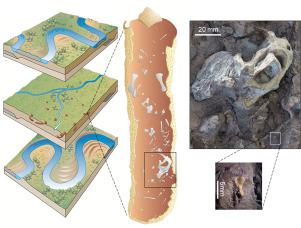Palaeogeography, Palaeoclimatology, Palaeoecology ( IF 3 ) Pub Date : 2021-03-05 , DOI: 10.1016/j.palaeo.2021.110311 Roger M.H. Smith , Kenneth D. Angielczyk , Julien Benoit , Vincent Fernandez

|
In the late 1980's the discovery of late Permian helical burrow casts containing articulated skeletons of the small herbivorous therapsid Diictodon feliceps led to conjecture that they may have been used for oviposition/parturition and shelter for infants. Here we present new fossil evidence in support of this interpretation and discuss the possibility that some of the burrows were specially excavated as brood chambers. A re-investigation of the original helical burrow site recovered several more burrow casts containing scattered yet still-associated skeletons of Diictodon. Mechanical preparation of a complete terminal chamber revealed a disarticulated but anatomically-associated adult Diictodon skeleton along with a single tiny (5 mm long) humerus of an infant dicynodont. Nearby outcrops yielded a second association of an adult Diictodon skull (skull length 93 mm) on top of a tiny semi-articulated Diictodon skull and skeleton (skull length 19 mm) with a second infant mandible and a skeleton of the gracile therocephalian Ictidosuchoides longiceps. Synchrotron imaging of this putative burrow-fill confirmed that the humeral morphology of the infant skeleton closely matches the tiny humerus in the unequivocal burrow cast. The common occurrence of Diictodon remains within the casts, combined with their specialized limbs for digging and histological data that indicates uninterrupted growth to ca. 70% of adult size, strongly suggests that they dug underground primarily for thermo-regulation. Moreover, our new fossil evidence of behaviourally-associated neonate and adult Diictodon within these structures indicates that the terminal portions of underground burrows were facultatively used as brood chambers.
中文翻译:

新生儿聚集在二叠纪二齿兽下目双齿兽属(兽孔目,Anomodontia):证据的洞穴生殖功能?
在1980年代后期,发现了二叠纪晚期螺旋洞穴铸件,其中包含小型食草治疗性Diictodon feliceps的关节骨骼,这使人们推测它们可能已被用于产卵/分娩和为婴儿提供庇护所。在这里,我们提供了新的化石证据来支持这种解释,并讨论了某些洞穴被专门挖掘为巢室的可能性。重新调查了原始的螺旋洞穴位置,发现了更多的洞穴铸件,这些铸件包含散落但仍关联的Diictodon骨骼。机械准备完一个完整的终末室后,发现脱臼但与解剖学相关的成年鼠齿龙骨骼,以及婴儿双突齿的单个微小(5毫米长)肱骨。附近的露头产生了一个成年的Diictodon头骨(头骨长93 mm)在一个微小的半关节Diictodon头骨和骨架(头骨长19 mm),第二个婴儿下颌骨和轻柔的头颅类Ictidosuchoidoids longiceps骨骼之间的第二次关联。对这种推测的洞穴填充物进行同步成像证实,婴儿骨骼的肱骨形态与明确的洞穴石膏中的微小肱骨紧密匹配。Diictodon的常见现象仍保留在石膏中,并结合其专门的四肢进行挖掘和组织学数据,表明生长至约3年不间断。成年人的70%强烈建议他们主要在地下挖土以进行温度调节。此外,我们在这些结构中行为相关的新生儿和成年鼠齿象的新化石证据表明,地下洞穴的末端部分被兼作育雏室。



























 京公网安备 11010802027423号
京公网安备 11010802027423号